2 甘肃省油气资源研究重点实验室/中国科学院油气资源研究重点实验室, 甘肃 兰州 730000;
3 中国科学院地质与地球物理研究所, 中国科学院新生代地质与环境重点实验室, 北京 100029;
4 中国科学院大学, 北京 100049)
长链烯酮(Long-chain alkenones,简称LCAs)是由定鞭金藻(Haptophytes)合成的长链不饱和甲基酮或乙基酮,碳数范围在C37~C41之间,特征为含有不同数量的(2~4个)反式碳-碳双键。在烯酮母源藻的生长过程中,随着温度的升高或降低,烯酮中反式双键的数量会相应减少或增加[1~8]。例如,当赫式颗石藻(Emiliania huxleyi)处于最佳生长温度时(约25 ℃),主要产生含有两个不饱和键的长链烯酮(C37:2),而当其处于低温条件下(大约10 ℃),会产生大量含有3个不饱和键的长链烯酮(C37:3)[7]。因此,沉积物中二不饱和烯酮与三不饱和烯酮的比值可以用来估算地质时期中烯酮母源藻生长时的表层水体温度[9]。Brassell等[9]最早基于海水温度变化下的烯酮响应机制建立了U37k分子温度计(U37k=(C37:2-C37:4)/(C37:2+C37:3+C37:4))。随后,由于海洋沉积物中C37四不饱和烯酮(C37:4)的含量很低难以检测,Prahl和Wakeham[7]剔除了C37:4,提出了U37k′(U37k′=C37:2/(C37:2+C37:3))。U37k′指数与烯酮母源藻的生长温度显著相关,并且随着温度升高,C37:3烯酮的含量相对减小,因此,U37k′逐渐替代了U37k,用于古温度的重建。
湖相LCAs的出现被认为与盐度有关,因为在许多蒸发环境下的湖泊中都检出了LCAs[6, 10~13]。例如,在西格陵兰湖,以碳酸盐岩为主的低盐湖泊中发现了异常丰富的LCAs,而在附近的淡水湖中却没有发现LCAs的存在[14]。类似情况在北美大平原的湖泊研究中也有出现,在该区域13个含烯酮的湖泊中12个为高盐湖泊[15]。Pearson等[16]报道显示,西班牙湖泊中LCAs的出现也仅限于高盐度环境,且LCAs在以硫酸盐为主的湖泊中更为丰富。近年来研究表明,C37:4烯酮占总C37烯酮的百分数(% C37:4)可以反映海水盐度变化[17~21]。而对湖相LCAs的研究也证实,相较于更加饱和的C37:3和C37:2烯酮,C37:4烯酮的生物合成可能更具独立性[22],因此,% C37:4可以定性的反映区域盐度的变化特征,且% C37:4随着表面盐度的降低而增加[20]。除此之外,在一些高盐度的湖泊或沿海环境中还检测出了更高碳数的烯酮,如C40~C42长链烯酮,指示C40~C42烯酮可以作为高盐度环境的指标[11, 23~24]。
此外,烯酮单体氢同位素组成(δ2HC37)能够很好的反映古水体的演化,因而广泛应用于古盐度和古海/湖平面高度的重建[20, 25~26]。并且,利用湖泊中烯酮的单体碳同位素(δ13C37:2)和水体溶解CO2的碳同位素组成差值还可以估算水体溶解CO2浓度(同位素分馏效应),从而恢复大气CO2分压,以此计算大气CO2浓度(pCO2)[27~29]。
然而,相比于海洋环境,湖泊中烯酮母源藻更具多样性和复杂性,且不同藻类对环境温度的响应存在较大差异[30~31],因此在湖泊环境中应用烯酮指标时需要考虑烯酮母源藻的变化。青藏高原地区湖泊分布广泛,湖泊总面积达369×106 km2,但高原湖泊中长链烯酮的研究较少[32~34]。此外,对柴达木盆地湖泊中长链烯酮的分布特征和应用仍缺乏较系统的认识。本次研究采集了柴达木盆地尕海湖、托素湖和可鲁克湖这3个湖泊以及青海湖的现代表层沉积物,并钻取了可鲁克湖的沉积物岩芯,以探究湖泊中长链烯酮的分布、丰度和变化趋势,为长链烯酮在湖泊古环境重建中的应用提供依据。
1 实验及方法 1.1 样品采集2017年9月,在青藏高原东北部柴达木盆地,分别采集了青海湖、尕海湖、可鲁克湖和托素湖共4个湖泊表层沉积物样品(图 1)。其中,可鲁克湖属于淡水湖,水体盐度约为1.0 g/L,而青海湖、尕海湖和托素湖均为咸水湖,湖水盐度分别为14.6 g/L、94.4 g/L和27.8 g/L[35~37]。

|
图 1 研究区地理位置及概况图 (a)青藏高原东北部可鲁克湖和青海湖位置示意图,灰色实线描绘了青藏高原地理轮廓,灰色虚线表示柴达木盆地轮廓,深蓝色虚线为现代东亚季风边界;(b)德令哈附近气象站记录的1956~1991年平均月温度,降水量和蒸发量;(c)本次研究区位置图及采样点位 Fig. 1 Geographical location and overview of the study area. (a)Map showing location of Hurleg Lake and Qinghai Lake on the northern Tibetan Plateau, the bold gray line approximately depicts the outline of the Tibetan Plateau, the dashed gray line indicates the Qaidam Basin, and the dashed dark blue line represents the boundary of the modern East Asian monsoon; (b)Monthly temperature, precipitation and evaporation during 1956~1991 at the nearby Delingha weather station; (c)Locations of this study sampling |
此外,课题组于2018年6月,在可鲁克湖湖边湿地(37°15′10.91″N,96°51′06.06″E),采用便携式手持动力取样钻机取得520 cm长的沉积物岩芯。将岩芯用干净的铝箔纸包裹,标记后运回实验室进行后续的处理和分析测试。
1.2 酮类组分提取与测试将冷冻干燥后的样品研磨至大于100目,使用加速溶剂提取法(ASE,Thermo Scientific),称取30 g样品装入萃取池中,萃取溶剂为二氯甲烷/甲醇混合液(DCM/MeOH,9 ︰ 1,v/v)和乙酸乙酯(EAC),萃取条件为100 ℃和1.5×106 Pa,分别抽提3次。将6次提取液转移至锥形瓶中合并,利用旋转蒸发仪将其浓缩至3 ml左右,转入30 ml样品瓶,用精制的二氯甲烷溶剂清洗锥形瓶4次,每次5 ml,并将清洗液倒入样品瓶,以确保抽提物尽可能全部转出。之后利用高纯氮气将总抽提物吹干,进行皂化和水解。配置6 % KOH的甲醇溶液,并量取4 ml加入到每个样品的样品瓶中,拧紧样品瓶盖,超声震荡15 min,之后放置室温下静置12 h。静置完成后,加入4 ml的5 % NaCl溶液,超声震荡15 min,接着用正己烷萃取4次,萃取物吹干后利用柱色谱法分离。分离过程中以正己烷、二氯甲烷和甲醇为洗脱剂,获得3个组分,其中二氯甲烷淋洗获得的第二个组分中包含长链烯酮及中位酮系列。
酮类组分的测试是在中国科学院西北生态环境资源研究院兰州油气资源研究中心进行。仪器为气相色谱质谱联用仪(Agilent,6890N-5973N),色谱柱为HP-5MS弹性石英毛细管柱(30 m×0.25 mm×0.25 μm)。柱温程序是40 ℃保持1 min,先以4 ℃/min的升温速率升到100 ℃,再以2 ℃/min的升温速率升至310 ℃,保持30 min。载气为99.995 % 高纯氦气,质谱扫描模式为全扫描(m/z=10~650 Da),离子源为EI源,离子源温度230 ℃,电子能量70 eV,四极杆温度150 ℃。
1.3 可鲁克湖年代模式建立可鲁克湖沉积物钻孔年代学框架基于放射性碳(ASM 14C)和古地磁长期变定年方法建立[38]。首先选取可鲁克湖沉积岩芯柱不同深度的样品(10 cm、50 cm、272 cm、380 cm、400 cm、482 cm和500 cm)进行ASM 14C定年,其中400 cm处定年材料为植物残体,其余为全岩有机质。所有样品的ASM 14C定年均在美国BETA实验室完成测试。7个样品的ASM 14C测试及校正结果见表 1。
| 表 1 可鲁克湖沉积物ASM 14C定年结果表 Table 1 ASM 14C ages for Hurleg Lake core sediments |
考虑到湖泊可能存在的“碳库效应”,采用古地磁长期变对钻孔年代进行了再次测试。测试前首先对样品进行了岩石磁学和环境磁学实验,确定磁化率(χ)、非磁滞剩磁(ARM)、饱和等温剩磁(SIRM)等参数符合“均一性”的岩石磁学标准,可以进行相对古强度的研究。然后利用这3个参数对天然剩磁(NRM30mT,经30 mT退磁后的天然剩磁)进行归一化处理[39~40]。结果表明,不同方法得到的可鲁克湖钻孔的相对古地磁强度基本一致。本研究以NRM30 mT/SIRM为相对古强度变化曲线,与全球具有确定年龄的相对古强度曲线进行对比得到可鲁克湖钻孔的确定年龄[41~44]。本研究的所有磁学实验均在中国科学院地质与地球物理研究所古地磁与年代学实验室完成。
古地磁长期变结果表明,可鲁克湖钻孔在0~272 cm深度之间存在碳库效应,而大于272 cm深度处无碳库效应影响,古地磁测试结果与ASM 14C定年一致[38]。因此,钻孔上部(0~272 cm)由于碳库效应的存在而使用古地磁定年数据,下部无碳库效应存在使用古地磁和ASM 14C定年相结合的方法确定钻孔年代。将扣除碳库后的年龄使用树轮年代校正软件Bacon将年代校正到日历年,获得可鲁克湖钻孔年代-深度模型,其年代范围为16.1~0.2 cal.ka B.P.[38]。
3 结果 3.1 湖泊表层沉积物长链烯酮和中位酮系列化合物本次在青海湖、尕海湖、托素湖和可鲁克湖的4个表层沉积物样品中均检出了长链烯酮系列化合物。如图 2所示,各湖泊沉积物中长链烯酮的分布模式相似,主要以C37和C38系列为主,并显示为C37系列优势模式。C37烯酮是由C37:4、C37:3和C37:2这3个异构体组成的,C38烯酮是由C38:4、C38:3和C38:2这3个异构体组成的,且均以3个碳-碳双键的烯酮(C37:3和C38:3)为主峰。长链烯酮C37/C38比值被认为能够用来辨别烯酮母源藻[6, 16, 20],在本次研究中,尕海湖、托素湖和可鲁克湖的烯酮C37/C38比值较为接近,分别为1.67、1.96和1.12,而青海湖的烯酮C37/C38比值较高,约为7.10(表 2)。
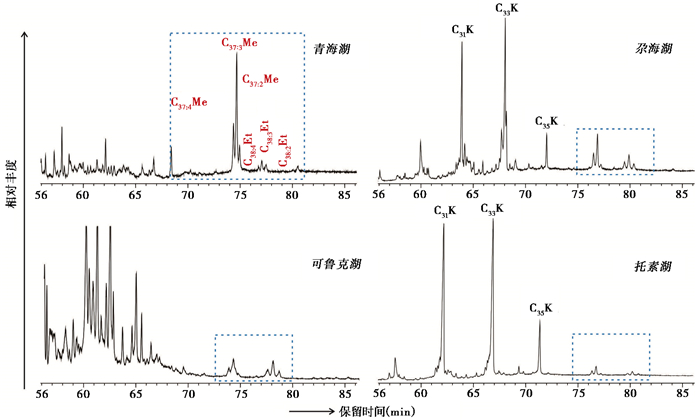
|
图 2 湖泊表层沉积物长链烯酮和中位酮系列化合物色谱图(Me:甲基烯酮;Et:乙基烯酮) Fig. 2 LCAs and mid-chain ketones in lake surface sediments(Me: Methyl alkenone; Et: Ethyl alkenone) |
| 表 2 研究区湖泊特征及表层沉积物的烯酮分布 Table 2 The characteristics of investigated lakes and alkenones in sediments |
C37:4烯酮占总C37烯酮的百分数(% C37:4)可以反映海水盐度变化[17~20],在本次研究中,湖泊表层沉积物% C37:4值与湖泊盐度值变化较为一致,表现为尕海湖>托素湖>青海湖>可鲁克湖(表 2)。
此外,在托素湖和尕海湖表层沉积物中,本次研究还检测到了丰度较高的中位酮系列化合物,即C31-16-one(C31K)、C33-17-one(C33K)和C35-18-one(C35K),该系列化合物具有明显的奇碳优势,质谱图如图 3所示。

|
图 3 中位酮系列化合物质谱图(M:分子量) Fig. 3 Mass spectrogram of mid-chain ketones(M: Molecular Weight) |
对可鲁克湖沉积物岩芯样品进行了长链烯酮的分析测试,并在370~442 cm深度区间样品中检测到烯酮类化合物,由于其他深度对应的样品未检出该类化合物,因此只能对370~442 cm深度处的烯酮进行讨论。370~442 cm深度区间对应于10.5~7.7 cal.ka B.P.,即早-中全新世期间。
如图 4所示,可鲁克湖沉积物岩芯长链烯酮同样以C37和C38系列为主,并显示为C37系列优势模式。此外,烯酮C37/C38值范围在1.49~4.26之间,平均值为2.0,除422 cm深度处(对应于9.5 cal.ka B.P.)样品具有C37/C38的最大值4.26以外,其他样品的C37/C38比值差别较小。可鲁克湖沉积物岩芯% C37:4值变化范围较小,在8.49 %~16.79 % 之间(图 5)。
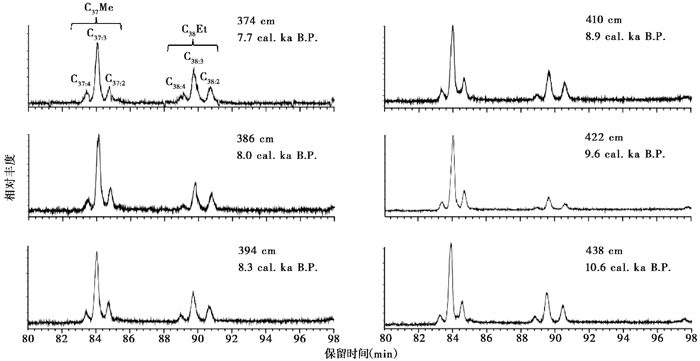
|
图 4 可鲁克湖钻孔不同深度沉积物长链烯酮色谱图 Fig. 4 Mass chromatogram of LCAs in Hurleg Lake sediments core of different depths |
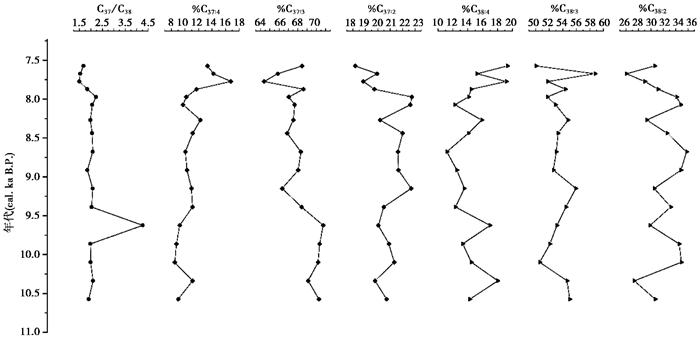
|
图 5 可鲁克湖沉积物长链烯酮相对含量与比值变化图 Fig. 5 Relative contents and ratios of LCAs in Hurleg Lake core sediment |
与此同时,在可鲁克湖沉积物岩芯中同样检出了丰富的中位酮系列化合物,即C31K、C33K和C35K,且以C31为主峰(图 6)。但值得注意的是,该系列化物仅在8~408 cm深度处的样品中检出,对应的年代为8.7 cal.ka B.P. 以来,早于8.7 cal.ka B.P. 的样品中未检出,其含量明显低于检测限。

|
图 6 可鲁克湖不同深度沉积物中位酮色谱图 Fig. 6 Mass chromatogram of mid-chain ketones in Hurleg Lake core sediments of different depths |
Theroux等[45]将目前已知的烯酮母源藻分为3个类群,即Group Ⅰ、Group Ⅱ和Group Ⅲ。Group Ⅰ是尚未分离出纯菌株的定鞭藻,但在淡水环境样本中使用Rubisco小亚单位(SSU)rRNA的环境基因组学鉴定出的假定的定鞭藻菌株;Group Ⅱ包括Isochrysis galbana、Tisochrysis lutea、Ruttnera lamellose(改自Chrysotila lamellosa),它们属于Isochrysidaceae科,代表了在沿海地区、微咸水域和盐湖等多种环境中发现的物种;Group Ⅲ包括具有海洋环境特征的Emiliania huxleyi和Gephyrocapsa oceanica,属于Noëlaerhabdaceae科。湖泊烯酮母源具有较高的复杂性,烯酮母源藻种属比海洋环境的多样性更高[45~46],18S rRNA序列构建的系统发育树也显示湖泊烯酮母源藻主要集中在Group Ⅰ和Group Ⅱ [45~47]。
本次在柴达木盆地3个湖泊,即尕海湖、托素湖和可鲁克湖的湖泊表层沉积物中均检测到了长链烯酮系列化合物,且其具有相近的C37/C38比值,暗示这3个湖泊可能具有相同的烯酮母源藻。长链烯酮分布特征表现为C37:3甲基酮和C38:3乙基酮在同碳数系列中丰度最大,且C37:4甲基酮和C38:4乙基酮的丰度相对较高,表明这些湖泊中的烯酮母源不是C37:4含量低的Group Ⅲ系列(Emiliania huxleyi和Gephyrocapa oceanica),也不是滨海种Isochrysis galbana[6, 45],因为它不含C38:4乙基酮。此外,本次研究样品中也未检出C38:4甲基酮,这与等鞭金藻Chrysotila lamellose的培养实验结果相似[12]。测序结果也显示,可鲁克湖和托素湖母源同时存在Group Ⅰ和Group Ⅱ两个系列,具有一定的复杂性[45]。
青海湖是青藏高原首次检测到长链烯酮的湖泊,李景贵等[48]认为单鞭金藻属(Chromulina sp.)可能是青海湖烯酮的母源藻;Wang等[30]基于“物种效应”提出了新的烯酮指标U37ks,并认为青海湖烯酮具有多个母源,如Chrysotila lamellosa和Isochrysis galbana;Liu等[20]对青海湖长链烯酮的研究表明,青海湖沉积物中烯酮C37/C38比值范围在0.2~7.8之间,暗示烯酮母源藻具有一定的复杂性。此外,对已发表的青海湖烯酮数据[20]进行重新编译(图 7),发现青海湖沉积物烯酮的% C37:4和C37/C38比值具有一定的负相关性。然而,在柴达木盆地的湖泊中,如可鲁克湖、托素湖和尕海湖沉积物中烯酮的% C37:4和C37/C38比值显示出微弱的正相关关系,且湖泊表层沉积物% C37:4值与湖泊实际盐度值变化一致,这与前人研究得出的% C37:4与盐度呈负相关的结论[20]相矛盾。Coolen等[49]通过基因测序分析指出,烯酮对盐度的响应是通过藻类群落结构的变化而反映出来的,并不是单一的藻类对盐度产生的生理响应;吴霞等[34]也发现在库赛湖岩芯中% C37:4与盐度并没有明显的相关性,认为库赛湖中的烯酮母源藻较为单一,无法对群落结构产生影响,进而不能通过% C37:4反映盐度变化。
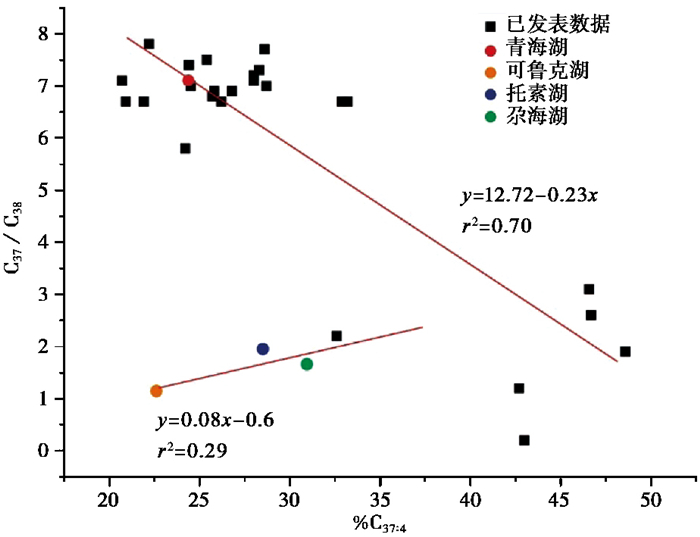
|
图 7 % C37:4和C37/C38关系图 Fig. 7 Alkenone % C37:4 changes with C37/C38 in different lakes in Qaidam Basin |
可鲁克湖主要由巴音河补给,湖水最终流入托素湖,托素湖是可鲁克湖的尾闾湖,尕海湖距离可鲁克湖约40 km,3个湖泊的水体均为SO4-Na ·Mg型,且烯酮比值C37/C38较为一致[35, 50~51],因此,这3个湖泊的烯酮母源藻类型可能是一致的。然而,由于湖泊水体盐度和营养条件不同,湖泊中烯酮母源藻的群落结构组成可能具有较大的差异,且不同藻类群落结构对盐度的响应机制也可能不同,因此导致% C37:4与盐度的关系具有一定的不确定性。
4.2 柴达木盆地长链烯酮记录对比柴达木盆地地区长链烯酮的研究较少,仅在可鲁克湖和尕海湖有过报道[33, 52~54]。例如,Zhao等[33]通过对可鲁克湖HL06-1钻孔长链烯酮的分析,揭示了该区距今9 ka以来存在的6次千年尺度的冷事件,并指出全新世中期以来气候不稳定性增强。然而,对柴达木盆地尕海湖钻孔长链烯酮的研究表明,由于烯酮母源藻种属发生变化,C37烯酮不饱和指数(U37k,U37k′或U37k″)不能简单的用于尕海湖的古温度重建[53]。Wang等[30]对青海湖的研究也表明,“物种效应”会影响烯酮不饱和指数,从而降低温度指标的准确性。
本次研究仅在10.5~7.7 cal.ka B.P.,即早-中全新世期间检测到长链烯酮系列化合物,可能是由于检出限较低或沉积时期无烯酮母源藻贡献,其他深度处未检出该类化合物。已有研究表明,定鞭藻需要阳光进行光合作用,通常生存在湖泊上层的透光区[55~56]。因此,在10.5~7.7 cal.ka B.P. 期间检出了烯酮表明该时期内采样点水体深度适宜烯酮母源藻的生长,而其他时间段内可能由于水体较深或较浅导致烯酮母源藻不能繁殖,因此未产生烯酮类化合物。
将本次实验结果与青海湖和可鲁克湖已发表的烯酮记录[30, 33, 52, 57]进行对比。如图 8a和8b所示,青海湖烯酮记录显示,10.5~7.7 ka B.P. 期间温度较低,气温呈缓慢升高的趋势,而本次研究结果显示该期间内温度较高,且较为稳定。由于未建立区域性的校准方程,Zhao等[33]基于长链烯酮温度指标建立了可鲁克湖HL06-1钻孔9 ka B.P. 以来的温度变化幅度曲线。本次研究结果与该记录较为一致,但存在一定差异,HL06-1钻孔显示9.0~8.0 ka B.P. 期间存在一次千年尺度的冷事件[33],而本次研究结果显示该期间温度接近平均值,降温幅度不大,并在此基础上将该记录延长至10.5 ka B.P.(图 8c)。此外,可鲁克湖HL06-1钻孔显示10.5~7.7 ka B.P. 期间% C37:4值较高且波动较大,对应湖水盐度较低[57],而本次研究结果显示% C37:4值较低且较为稳定(图 8d)。考虑到本次采样点位置离湖心较远,目前正处于湖泊外围湿地,因此,可能是采样点位置不同,且烯酮母源藻在湖泊中分布不均,从而导致古记录产生差异。Liu等[20]对青海湖湖泊沉积物进行了系统的采集和烯酮的测试分析,发现湖泊内不同位置烯酮的分布明显不同,例如,浅水区(深度在0.5 m左右)的U37k值范围在-0.08~-0.42之间,% C37:4值范围在24.8~48.6之间;而在深水区(深度在22.0~26.5 m之间),其U37k值范围为-0.11~-0.24,% C37:4值范围为22.2~33.2,显然,浅水区的U37k和% C37:4值波动较大且较不稳定,可能是浅水区烯酮母源藻群落结构与湖泊中心存在差异,或是浅水区水动力较强携带了湖泊内的部分藻类并使之沉积下来。
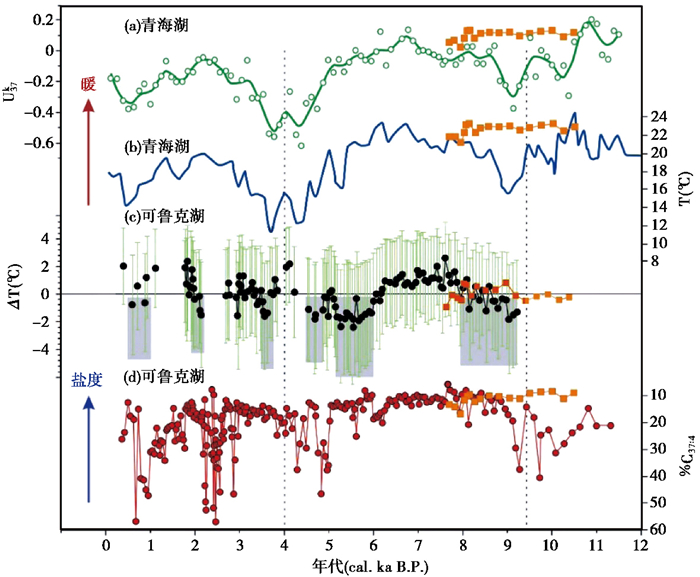
|
图 8 青海湖和可鲁克湖烯酮记录对比[30, 33, 52, 57](橘色实心正方形代表本次研究结果) Fig. 8 The records of alkenones[30, 33, 52, 57] for Qinghai Lake and Hurleg Lake |
上述研究结果表明,光照条件、营养物质、水体盐度和水深等均会影响烯酮母源藻的群落结构和生长状况,进而影响长链烯酮的分布。因此,在利用烯酮代用指标重建古气候古环境时,需综合分析,判断环境因素可能对烯酮分布产生的影响,进而获得准确的古记录。
不仅如此,在综合分析青藏高原湖泊烯酮数据的基础上,前人研究指出青藏高原不同湖泊中的烯酮对温度的响应存在差异,其中高原中西部湖泊沉积物烯酮指标能够很好的反映年均大气温度,而柴达木盆地湖泊烯酮与温度的相关性较低[31, 54]。付明义等[54]对青海湖和柴达木盆地湖泊的烯酮分布特征进行了详细的研究,发现青海湖地区烯酮和温度的重现性很好,而柴达木盆地地区烯酮恢复的温度偏低,他们认为长链烯酮母源藻的物种效应,母源藻繁殖期的生长条件变化(如盐度和营养水平等)可能影响了烯酮-温度的相关性;并且,柴达木盆地湖泊多为小型湖泊,因此湖泊沉积速率差异也可能会影响烯酮母源藻的生长和烯酮的分布。此外,柴达木盆地湖泊特殊的自然条件,如“温度梯度小,但盐度梯度大”的特性也可能是烯酮温度效应不明显的原因[37]。
4.3 青藏高原柴达木盆地湖泊中位酮来源分析本研究除长链烯酮外,在酮类组分中还检测出C31-16-one(C31K)、C33-17-one(C33K)和C35-18-one(C35K),表现为随着碳数增加,化合物丰度明显减小,即C31K>C33K>C35K。沉积有机质中较为常见的是脂肪酮,并且主要为2位脂肪酮系列化合物,部分样品中也可检测到3、4、5和6位的脂肪酮系列[58~59]。然而,长链中位酮在一般的地质样品中很难检出。Boon等[60]最早在沃尔维斯湾海相沉积物的硅藻软泥中检出了C38-19-one和C40-19-one系列中位酮,但其来源并不清楚。Cranwell[61]在湖相沉积物中检出了具有奇碳数优势的中位酮系列化合物,主峰碳为C31,认为该系列化合物来源于高等植物的蜡质组分;Kolattukudy等[62]从高等植物中分离出了中位酮化合物,表明其存在于叶片和果实中的角质层,认为中位酮化合物是由烃类生物合成的,其链长与烃类分布密切相关,这解释了中位酮系列化合物的奇碳优势特征;此外,Raven等[63]在考古的陶瓷器皿中检出了与本文分布相似的中位酮系列化合物,推测是在烹饪过程中植物叶片进入陶瓷缝隙而保存下来的,并提出该系列化合物是由脂肪酸和醇类经脱羧反应后形成的;孙敏卓等[64]在塔里木盆地海相碳酸盐岩芳烃馏分中同样检测到了中位酮,并认为这类化合物是脂肪酸盐热演化过程的特殊产物。由此可见,长链中位酮的母质来源还存在较大的不确定性。
本次研究在8~408 cm深度范围内的样品中检出了中位酮系列化合物,对应的年代为8.7 cal.ka B.P. 以来。该时期内钻孔中检出的正构烷烃呈长链烷烃分布优势[65]。已有研究表明,除了陆源高等植物以外,沉水植物对湖泊沉积物中的nC27和nC29正构烷烃输入有较大贡献,而nC31正构烷烃主要来源于陆生植物[66~70]。因此,本文选取长链正构烷烃的相对含量(即nC27 %、nC29 % 和nC31 %)为参数,探讨中位酮系列化合物的可能来源。如图 9所示,在8.7~4.0 ka B.P. 期间,C31中位酮百分含量(C31K %)整体呈逐渐升高的趋势,C33和C35中位酮百分含量(C33K % 和C35K %)表现为逐渐减小的趋势,而nC27 %、nC29 % 和nC31 % 在该时期内较为波动,无显著的增减趋势;4.0 ka B.P. 以来,C31K % 和nC27 % 缓慢减小,C33K %、C35K % 和nC31 % 缓慢增加,表明C31K的来源可能是沉水植物,而C33K和C35K可能来源于高等植物。为了进一步探究C31K与沉水植物的关系,我们使用刘虎等[71]新提出的P′ aq指标(改进的大型水生植物比例指标)进行分析,相较于Paq值,该指标可以更好地用于区分陆生和水生植物来源的正构烷烃。结果表明,C31K与P′ aq有一定的相关性,在6.0~4.0 ka B.P. 期间沉水植物输入量增多,C31K含量升高;4.0 ka B.P. 以来,沉水植物贡献量降低,C31K含量减少。8.7~6.0 ka B.P. 期间,虽然P′ aq值较为波动,但也有一定的增加趋势,与C31K的升高相对应。然而,在8.7~4.0 ka B.P. 期间,C33K % 和C35K % 表现出逐渐减小的趋势,而nC31 % 较为稳定。刘虎等[72]对青藏高原湖泊中水生植物的正构烷烃分布进行研究后发现,藻类和沉水植物均能够产生nC31正构烷。
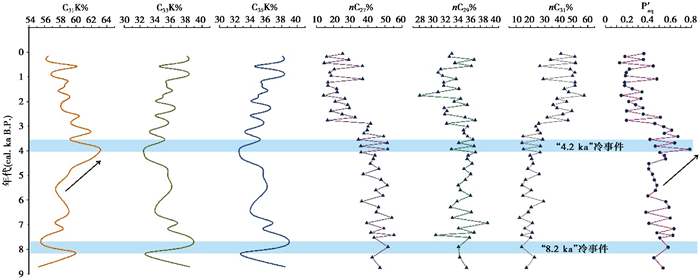
|
图 9 可鲁克湖沉积物中位酮相对含量与正构烷烃指标对比图 Fig. 9 The relative contents of mid-chain ketones in the core sediments of Hurleg Lake and comparison with alkanes proxies |
综上所述,在8.7~4.0 ka B.P. 期间,湖泊中的沉水植物可能较为繁盛,贡献了大量的长链正构烷烃,因此nC27 %、nC29 % 和nC31 % 较为稳定,而4.0 ka B.P. 以来,沉水植物衰退,陆生植物输入量增大,导致nC27 % 减小,而nC31 % 大幅增加。通过中位酮与正构烷烃的对比分析,我们认为C31K可能来源于沉水植物,而C33K和C35K可能来源于陆生植物。不仅如此,研究发现全新世期间著名的两个冷事件,“8.2 ka”和“4.2 ka”事件[73~78]在中位酮的含量变化曲线上有很好的反映,表现为C31K % 显著减小,而C33K % 和C35K % 急剧增加。相反,在正构烷烃分布上并没有很好的响应,说明中位酮系列化合物能够反映气候变化,且在区分湖泊沉积物有机质来源为沉水植物还是陆源植物输入时具有重要的指示意义。
5 结论本文通过对青藏高原柴达木盆地尕海湖、托素湖、可鲁克湖和青海湖的表层沉积物,以及可鲁克湖的沉积物钻孔展开有机地球化学分析,报道了柴达木盆地湖泊长链烯酮的存在和分布,并发现柴达木盆地湖泊沉积物中长链烯酮分布特征表现为C37优势特征,C37:3甲基酮和C38:3乙基酮在同碳数系列中丰度最大,且C37:4甲基酮和C38:4乙基酮的丰度相对较高。其中,可鲁克湖、托素湖和尕海湖距离较近,且C37/C38比值较为一致,暗示这3个湖泊可能具有相同的烯酮母源藻。
与前人研究结果不同,本次研究表明柴达木盆地湖泊% C37:4值与湖泊盐度变化呈正相关关系,可能是由于柴达木盆地湖泊中烯酮母源藻群落结构的不同以及对盐度响应机制的差异所造成的。对可鲁克湖沉积物钻孔的烯酮记录进一步分析表明,本次研究中在10.5~7.7 ka B.P. 期间,烯酮恢复的古温度值较高,而% C37:4值较低且较为稳定,与该区已发表的烯酮记录存在一定的差异性,可能是采样点位置、烯酮母源藻的物种效应,母源藻繁殖期的生长条件变化(如盐度和营养水平等),以及柴达木盆地湖泊特殊的自然条件所造成的。
此外,本次研究首次确认并报道了柴达木盆地湖泊中中位酮的存在(C31-16-one、C33-17-one和C35-18-one),该系列化合物具有明显的奇碳优势,并表现为随着碳数增加,化合物丰度明显减小的变化趋势。通过与可鲁克湖沉积物岩芯的正构烷烃参数对比,发现C31中位酮可能来自于沉水植物,而C33和C35中位酮可能来源于高等植物的贡献。不仅如此,中位酮含量变化曲线很好的反映了全新世期间著名的两个冷事件,“8.2 ka”事件和“4.2 ka”事件,表现为C31中位酮含量降低,而C33和C35中位酮含量显著增加,说明中位酮系列化合物可能是指示气候环境变化的潜在指标。
| [1] |
Marlowe I T, Green J C, Neal A C, et al. Long chain(n-C37-C39) alkenones in the Prymnesiophyceae. Distribution of alkenones and other lipids and their taxonomic significance[J]. European Journal of Phycology, 1984, 19(3): 203-216. |
| [2] |
Cranwell P A. Long-chain unsaturated ketones in recent lacustrine sediments[J]. Geochimica et Cosmochimica Acta, 1985, 49(7): 1545-1551. DOI:10.1016/0016-7037(85)90259-5 |
| [3] |
Prahl F G, Muehlhausen L A, Zahnle D L, et al. Further evaluation of long-chain alkenones as indicators of paleoceanographic conditions[J]. Geochimica et Cosmochimica Acta, 1988, 52(9): 2303-2310. DOI:10.1016/0016-7037(88)90132-9 |
| [4] |
Volkman J K, Barrerr S M, Blackburn S I, et al. Alkenones in Gephyrocapsa oceanica: Implications for studies of paleoclimate[J]. Geochimica et Cosmochimica Acta, 1995, 59(3): 513-520. DOI:10.1016/0016-7037(95)00325-T |
| [5] |
Zink K G, Leythaeuser D, Melkonian M, et al. Temperature dependency of long-chain alkenone distributions in recent to fossil limnic sediments and in lake waters[J]. Geochimica et Cosmochimica Acta, 2001, 65(2): 253-265. DOI:10.1016/S0016-7037(00)00509-3 |
| [6] |
Chu G, Sun Q, Li S, et al. Long-chain alkenone distributions and temperature dependence in lacustrine surface sediments from China[J]. Geochimica et Cosmochimica Acta, 2005, 69(21): 4985-5003. DOI:10.1016/j.gca.2005.04.008 |
| [7] |
Prahl F G, Wakeham S G. Calibration of unsaturation patterns in long-chain ketone compositions for palaeotemperature assessment[J]. Nature, 1987, 330(6146): 367-369. DOI:10.1038/330367a0 |
| [8] |
Pan H, Sun M. Variations of alkenone based paleotemperature index(U37k') during Emiliania huxleyi cell growth, respiration(auto-metabolism) and microbial degradation[J]. Organic Geochemistry, 2011, 42(6): 678-687. DOI:10.1016/j.orggeochem.2011.03.024 |
| [9] |
Brassell S C, Eglinton G, Marlowe I T, et al. Molecular stratigraphy: A new tool for climatic assessment[J]. Nature, 1986, 320(6058): 129-133. DOI:10.1038/320129a0 |
| [10] |
Thiel V, Jenisch A, Landmann G, et al. Unusual distributions of long-chain alkenones and tetrahymanol from the highly alkaline Lake Van, Turkey[J]. Geochimica et Cosmochimica Acta, 1997, 61(10): 2053-2064. DOI:10.1016/S0016-7037(97)00038-0 |
| [11] |
Sun Q, Chu G, Li S, et al. Long-chain alkenones in sulfate lakes and its paleoclimatic implications[J]. Chinese Science Bulletin, 2004, 49(19): 2082-2086. DOI:10.1360/03wd0298 |
| [12] |
Sun Q, Chu G, Liu G, et al. Calibration of alkenone unsaturation index with growth temperature for a lacustrine species, Chrysotila lamellosa (Haptophyceae)[J]. Organic Geochemistry, 2007, 38(8): 1226-1234. DOI:10.1016/j.orggeochem.2007.04.007 |
| [13] |
Theissen K M, Zinniker D, Moldowan J M, et al. Pronounced occurrence of long-chain alkenones and dinosterol in a 25, 000-year lipid molecular fossil record from Lake Titicaca, South America[J]. Geochimica et Cosmochimica Acta, 2005, 69(3): 623-636. DOI:10.1016/j.gca.2004.07.004 |
| [14] |
D'Andrea W J, Huang Y. Long chain alkenones in Greenland lake sediments: Low δ13C values and exceptional abundance[J]. Organic Geochemistry, 2005, 36(9): 1234-1241. DOI:10.1016/j.orggeochem.2005.05.001 |
| [15] |
Toney J L, Huang Y, Fritz S C, et al. Climatic and environmental controls on the occurrence and distributions of long chain alkenones in lakes of the interior United States[J]. Geochimica et Cosmochimica Acta, 2010, 74(5): 1563-1578. DOI:10.1016/j.gca.2009.11.021 |
| [16] |
Pearson E J, Juggins S, Farrimond P, et al. Distribution and significance of long-chain alkenones as salinity and temperature indicators in Spanish saline lake sediments[J]. Geochimica et Cosmochimica Acta, 2008, 72(16): 4035-4046. DOI:10.1016/j.gca.2008.05.052 |
| [17] |
Rosel-Melé A. Interhemispheric appraisal of the value of alkenone indices as temperature and salinity proxies in high-latitude locations[J]. Paleoceanography, 1998, 13(6): 694-703. DOI:10.1029/98PA02355 |
| [18] |
Rosel-Melé A. Appraisal of a molecular approach to infer variations in surface ocean freshwater inputs into the North Atlantic during the last glacial[J]. Global and Planetary Change, 2002, 34(3): 143-152. |
| [19] |
Sicre M, Bard E, Ezat U, et al. Alkenone distributions in the North Atlantic and Nordic sea surface waters[J]. Geochemistry, Geophysics, Geosystems, 2002, 3(2): 1-13. |
| [20] |
Liu W, Liu Z, Fu M, et al. Distribution of the C37 tetra-unsaturated alkenone in Lake Qinghai, China: A potential lake salinity indicator[J]. Geochimica et Cosmochimica Acta, 2008, 72(3): 988-997. DOI:10.1016/j.gca.2007.11.016 |
| [21] |
Bendle J, Rosell-Melé A, Ziveri P. Variability of unusual distributions of alkenones in the surface waters of the Nordic seas[J]. Paleoceanography, 2005, 20(2). DOI:10.1029/2004PA001025 |
| [22] |
Freeman K H, Wakeham S G. Variations in the distributions and isotopic composition of alkenones in Black Sea particles and sediments[J]. Organic Geochemistry, 1992, 19(1-3): 277-285. DOI:10.1016/0146-6380(92)90043-W |
| [23] |
Farrimond P, Eglinton G, Brassell S C, et al. Alkenones in Cretaceous black shales, Blake-Bahama Basin, western North Atlantic[J]. Organic Geochemistry, 1986, 10(4): 897-903. |
| [24] |
Zhao J, An C, Longo W M, et al. Occurrence of extended chain length C41 and C42 alkenones in hypersaline lakes[J]. Organic Geochemistry, 2014, 75(1): 48-53. |
| [25] |
Sachs J P, Maloney A E, Gregersen J, et al. Effect of salinity on 2H/1H fractionation in lipids from continuous cultures of the coccolithophorid Emiliania huxleyi[J]. Geochimica et Cosmochimica Acta, 2016, 189(1): 96-109. |
| [26] |
Gould J, Kienast M, Dowd M, et al. An open-ocean assessment of alkenone δD as a paleo-salinity proxy[J]. Geochimica et Cosmochimica Acta, 2019, 246(1): 478-497. |
| [27] |
Weiss R F. Carbon dioxide in water and seawater: The solubility of a non-ideal gas[J]. Marine Chemistry, 1974, 2(3): 203-215. DOI:10.1016/0304-4203(74)90015-2 |
| [28] |
Pagani M. The alkenone-CO2 proxy and ancient atmospheric carbon dioxide[J]. Philosophical Transactions of the Royal Society of London, Series A: Mathematical, Physical and Engineering Sciences, 2002, 360(1793): 609-632. DOI:10.1098/rsta.2001.0959 |
| [29] |
Seki O, Foster G L, Schmidt D N, et al. Alkenone and boron based Pliocene pCO2 records[J]. Earth and Planetary Science Letters, 2010, 292(1): 201-211. |
| [30] |
Wang Z, Liu Z, Zhang F, et al. A new approach for reconstructing Holocene temperatures from a multi-species long chain alkenone record from Lake Qinghai on the northeastern Tibetan Plateau[J]. Organic Geochemistry, 2015, 88(88): 50-58. |
| [31] |
王明达, 李秀美, 梁洁, 等. 青藏高原湖泊长链不饱和烯酮研究现状及展望[J]. 第四纪研究, 2016, 36(4): 1002-1014. Wang Mingda, Li Xiumei, Liang Jie, et al. Progress in the studies of long chain unsaturated alkenones in Tibetan Plateau Lakes[J]. Quaternary Sciences, 2016, 36(4): 1002-1014. |
| [32] |
Wang Z, Liu W. Calibration of the U37k' index of long-chain alkenones with the in-situ water temperature in Lake Qinghai in the Tibetan Plateau[J]. Science Bulletin, 2013, 58(7): 803-808. DOI:10.1007/s11434-012-5527-y |
| [33] |
Zhao C, Liu Z H, Rohling E J, et al. Holocene temperature fluctuations in the northern Tibetan Plateau[J]. Quaternary Research, 2013, 80(1): 55-65. DOI:10.1016/j.yqres.2013.05.001 |
| [34] |
吴霞, 杨渐, 董海良, 等. 青藏高原北部库赛湖沉积柱中长链烯酮的分布特征及古环境意义[J]. 地球与环境, 2013, 41(4): 80-89. Wu Xia, Yang Jian, Dong Hailiang, et al. Distribution of long-chain alkenones and their implications for paleoenvironment from a sediment core of Kusai Lake, northern Tibetan Plateau[J]. Earth and Environment, 2013, 41(4): 80-89. |
| [35] |
付霞, 张家武, 王林, 等. 近期人类活动对湖泊沉积记录的影响——以托素湖为例[J]. 第四纪研究, 2016, 36(6): 1456-1465. Fu Xia, Zhang Jiawu, Wang Lin, et al. Recent human impacts on sedimentary record: A case from Lake Toson[J]. Quaternary Sciences, 2016, 36(6): 1456-1465. |
| [36] |
王素萍, 贾国东, 赵艳, 等. 柴达木盆地克鲁克湖全新世气候变化的正构烷烃分子记录[J]. 第四纪研究, 2010, 30(6): 1097-1104. Wang Suping, Jia Guodong, Zhao Yan, et al. Plant wax n-alkanes record of the Holocene paleoclimatic changes from a core sediment of Hurleg Lake in the Qaidam Basin[J]. Quaternary Sciences, 2010, 30(6): 1097-1104. DOI:10.3969/j.issn.1001-7410.2010.06.04 |
| [37] |
Liu W, Liu Z, Wang H, et al. Salinity control on long-chain alkenone distributions in lake surface waters and sediments of the northern Qinghai-Tibetan Plateau, China[J]. Geochimica et Cosmochimica Acta, 2011, 75(7): 1693-1703. DOI:10.1016/j.gca.2010.10.029 |
| [38] |
Ma H, Wang Y L, Jin C S, et al. Relative paleointensity correction of radiocarbon reservoir effect for lacustrine sediments on the northeast Tibetan Plateau[J]. Waiting for published
|
| [39] |
King J W, Banerjee S K, Marvin J. A new rock-magnetic approach to selecting sediments for geomagnetic paleointensity studies: Application to paleointensity for the last 4000 years[J]. Journal of Geophysical Research, 1983, 88(B7): 5911-5921. DOI:10.1029/JB088iB07p05911 |
| [40] |
Tauxe L. Sedimentary records of relative paleointensity of the geomagnetic-field: Theory and practice[J]. Reviews of Geophysics, 1993, 31(3): 319-354. DOI:10.1029/93RG01771 |
| [41] |
Nachasova I E, Burakov K S. The geomagnetic field intensity in Central Asia from 6000 to 3000 BC[J]. Izvestiya-Physics of the Solid Earth, 2000, 36(5): 358-363. |
| [42] |
Stoner J S, Channell J E T, Mazaud A, et al. The influence of high-latitude flux lobes on the Holocene paleomagnetic record of IODP Site U1305 and the northern North Atlantic[J]. Geochemistry, Geophysics, Geosystems, 2013, 14(10): 4623-4646. DOI:10.1002/ggge.20272 |
| [43] |
Pavón-Carrasco F J, Osete M L, Torta J M, et al. A geomagnetic field model for the Holocene based on archaeomagnetic and lava flow data[J]. Earth and Planetary Science Letters, 2014, 388(1): 98-109. |
| [44] |
Shin S, Park Y H, Park J H, et al. Relative paleointensity data from the Late Holocene deltaic sediments in Korea[J]. Geosciences Journal, 2015, 19(4): 579-585. DOI:10.1007/s12303-015-0066-6 |
| [45] |
Theroux S, D'Andrea W J, Toney J, et al. Phylogenetic diversity and evolutionary relatedness of alkenone-producing haptophyte algae in lakes: Implications for continental paleotemperature reconstructions[J]. Earth and Planetary Science Letters, 2010, 300(3-4): 311-320. DOI:10.1016/j.epsl.2010.10.009 |
| [46] |
Toney J L, Theroux S, Andersen R A, et al. Culturing of the first C37:4 predominant lacustrine haptophyte: Geochemical, biochemical, and genetic implications[J]. Geochimica et Cosmochimica Acta, 2012, 78(1): 51-64. |
| [47] |
D'Andrea W J, Theroux S, Bradley R S, et al. Does phylogeny control-temperature sensitivity? Implication for lacustrine alkenone paleothermometry[J]. Geochimica et Cosmochimica Acta, 2016, 175(1): 168-180. |
| [48] |
李景贵, 范璞, 崔明中, 等. 青海湖沉积物中的长链不饱和脂肪酮(长链烯酮)[J]. 沉积学报, 1995, 13(1): 1-6. Li Jinggui, Fan Pu, Cui Mingzhong, et al. Long-chain unsaturated ketones in Qinghai Lake sediments[J]. Acta Sedimentologica Sinica, 1995, 13(1): 1-6. |
| [49] |
Coolen M J L, Muyzer G, Rijpstra W I C, et al. Combined DNA and lipid analyses of sediments reveal changes in Holocene haptopbyte and diatom populations in an Antarctic lake[J]. Earth and Planetary Science Letters, 2004, 223(1-2): 225-239. DOI:10.1016/j.epsl.2004.04.014 |
| [50] |
郭小燕. 季风边缘区尕海湖记录的全新世气候变化[D]. 兰州: 兰州大学博士学位论文, 2012: 14-16. Guo Xiaoyan. Holocene Climate Change Documented by Lake Sediments from Lake Gahai in the Monsoonal Margin, Northwest China[D]. Lanzhou: The Doctoral Thesis of Lanzhou University, 2012: 14-16. |
| [51] |
王艺涵, 刘胤序, 刘海红, 等. 青海典型内陆河流域地表水化学组成及其重金属分布特征[J]. 生态学杂志, 2018, 37(3): 734-742. Wang Yihan, Liu Yinxu, Liu Haihong, et al. Chemical composition and heavy metal distribution in surface water of typical inland rivers in Qinghai[J]. Chinese Journal of Ecology, 2018, 37(3): 734-742. |
| [52] |
Hou J, Huang Y, Zhao J, et al. Large Holocene summer temperature oscillations and impact on the peopling of the northeastern Tibetan Plateau[J]. Geophysical Research Letters, 2016, 43(3): 1323-1330. DOI:10.1002/2015GL067317 |
| [53] |
Zhao J, Thomas E K, Yao Y, et al. Major increase in winter and spring precipitation during the Little Ice Age in the westerly dominated northern Qinghai-Tibetan Plateau[J]. Quaternary Science Reviews, 2018, 199(1): 30-40. |
| [54] |
付明义, 刘卫国, 李祥忠, 等. 青海湖及柴达木盆地地区现代湖泊沉积物中长链烯酮的分布特征[J]. 湖泊科学, 2008, 20(3): 285-290. Fu Mingyi, Liu Weiguo, Li Xiangzhong, et al. The distribution of long-chain alkenones in modern lacustrine sediments in the Lake Qinghai and lakes from the Qaidam Basin[J]. Journal of Lake Sciences, 2008, 20(3): 285-290. DOI:10.3321/j.issn:1003-5427.2008.03.004 |
| [55] |
Castañeda I S, Schouten S. A review of molecular organic proxies for examining modern and ancient lacustrine environments[J]. Quaternary Science Reviews, 2011, 30(21): 2851-2891. |
| [56] |
Longo W M, Huang Y, Yao Y, et al. Widespread occurrence of distinct alkenones from Group I haptophytes in freshwater lakes: Implications for paleotemperature and paleoenvironmental reconstructions[J]. Earth and Planetary Science Letters, 2018, 492: 239-250. DOI:10.1016/j.epsl.2018.04.002 |
| [57] |
He Y X, Zhao C, Liu Z H, et al. Holocene climate controls on water isotopic variations on the northeastern Tibetan Plateau[J]. Chemical Geology, 2016, 440(1): 239-247. |
| [58] |
Zhang Y, Huang X, Wang R, et al. The distribution of long-chain n-alkan-2-ones in peat can be used to infer past changes in pH[J]. Chemical Geology, 2020, 544(1): 119622. |
| [59] |
Zhang Z, Volkman J K. Isotopically enriched n-alkan-2-ones with even chain predominance in a torbanite from the Sydney Basin, Australia[J]. Organic Geochemistry, 2020, 144(1): 104018. |
| [60] |
Boon J J, De Leeuw J W. The analysis of wax esters, very long mid-chain ketones and sterol ethers isolated from Walvis Bay diatomaceous ooze[J]. Marine Chemistry, 1979, 7(2): 117-132. DOI:10.1016/0304-4203(79)90004-5 |
| [61] |
Cranwell P A. Lipid geochemistry of sediments from Upton Broad, a small productive lake[J]. Organic Geochemistry, 1984, 7(1): 25-37. DOI:10.1016/0146-6380(84)90134-7 |
| [62] |
Kolattukudy P E, Croteau R, Buckner J S. Biochemistry of plant waxes[M]//Kollattukudy P E ed. Chemistry and Biochemistry of Natural Waxes. Amsterdam: Elsevier, 1976: 289-347.
|
| [63] |
Raven A M, Van Bergen P F, Stott A W, et al. Formation of long-chain ketones in archaeological pottery vessels by pyrolysis of acyl lipids[J]. Journal of Analytical and Applied Pyrolysis, 1997, 40-41(1): 267-285. |
| [64] |
孙敏卓, 龙国徽, 孟仟祥, 等. 塔里木盆地海相碳酸盐岩沥青"A"的地球化学特征[J]. 岩矿测试, 2011, 30(5): 623-630. Sun Minzhuo, Long Guohui, Meng Qianxiang, et al. Geochemical characteristics of bitumen "A" in marine carbonate rock from the Tarim Basin[J]. Rock and Mineral Analysis, 2011, 30(5): 623-630. DOI:10.3969/j.issn.0254-5357.2011.05.020 |
| [65] |
Ma X Y, Wei Z F, Wang Y L, et al. Insolation and seasonal differences affecting C3 vs C4 plant abundance since the Late Deglacial on the northeastern Tibetan Plateau[J]. Waiting for published.
|
| [66] |
Aichner B, Herzschuh U, Wilkes H. Influence of aquatic macrophytes on the stable carbon isotopic signatures of sedimentary organic matter in lakes on the Tibetan Plateau[J]. Organic Geochemistry, 2010, 41(7): 706-718. DOI:10.1016/j.orggeochem.2010.02.002 |
| [67] |
Liu H, Liu W. n-Alkane distributions and concentrations in algae, submerged plants and terrestrial plants from the Qinghai-Tibetan Plateau[J]. Organic Geochemistry, 2016, 99(1): 10-22. |
| [68] |
Liu H, Liu W. Concentration and distributions of fatty acids in algae, submerged plants and terrestrial plants from the northeastern Tibetan Plateau[J]. Organic Geochemistry, 2017, 113(1): 17-26. |
| [69] |
Liu W G, Yang H, Wang H Y, et al. Influence of aquatic plants on the hydrogen isotope composition of sedimentary long-chain n-alkanes in the Lake Qinghai region, Qinghai-Tibet Plateau[J]. Science China: Earth Sciences, 2016, 59(7): 1368-1377. DOI:10.1007/s11430-016-5263-2 |
| [70] |
孙晓双, 张灿, 柴轶凡, 等. 云南高海拔湖泊对末次冰消期气候突变的响应[J]. 第四纪研究, 2019, 39(4): 975-984. Sun Xiaoshuang, Zhang Can, Chai Yifan, et al. High-altitude lake sediments in response to abrupt climate events during the last deglaciation in Southwestern China[J]. Quaternary Sciences, 2019, 39(4): 975-984. |
| [71] |
刘虎, 柳中晖, 赵成, 等. 水生植物烷基脂类含量和分布特征及其单体氢同位素组成[J]. 中国科学: 地球科学, 2019, 49(9): 1439-1451. Liu Hu, Liu Zhonghui, Zhao Cheng, et al. n-alkyl lipid concentrations and distributions in aquatic plants and their individual δD variations[J]. Science China: Earth Sciences, 2019, 49(9): 1439-1451. |
| [72] |
刘虎, 杨洪, 曹蕴宁, 等. 青藏高原地区湖泊正构烷烃有机单体氢同位素组成及其水文与环境应用[J]. 中国科学: 地球科学, 2018, 48(6): 778-791. Liu Hu, Yang Hong, Cao Yunning, et al. Compound-specific δD and its hydrological and environmental implication in the lakes on the Tibetan Plateau[J]. Science China: Earth Sciences, 2018, 48(6): 778-791. |
| [73] |
朱少航, 朱立平, 王君波, 等. 西藏玛旁雍错沉积揭示的晚冰期以来环境变化[J]. 第四纪研究, 2019, 39(3): 602-614. Zhu Shaohang, Zhu Liping, Wang Junbo, et al. Environmental changes reflected by core sediments since Late Glacial in Mapam Yumco, southwest Tibet of China[J]. Quaternary Sciences, 2019, 39(3): 602-614. |
| [74] |
Hong Y T, Hong B, Lin Q H, et al. Correlation between Indian Ocean summer monsoon and North Atlantic climate during the Holocene[J]. Earth and Planetary Science Letters, 2003, 211(211): 371-380. |
| [75] |
崔巧玉, 赵艳. 大兴安岭阿尔山天池湖泊沉积物记录的全新世气候突变[J]. 第四纪研究, 2019, 39(6): 1346-1356. Cui Qiaoyu, Zhao Yan. Climatic abrupt events implied by lacustrine sediments of Arxan Crater Lake, in the central Great Khingan Mountains, NE China during Holocene[J]. Quaternary Sciences, 2019, 39(6): 1346-1356. |
| [76] |
白雨洁, 吴江滢, 梁怡佳, 等. 湖北玉龙洞石笋多指标记录的4.2 ka事件[J]. 第四纪研究, 2020, 40(4): 959. Bai Yujie, Wu Jiangying, Liang Yijia, et al. The multi-proxy record of a stalagmite from Yulong Cave, Hubei during the 4.2 ka event[J]. Quaternary Sciences, 2020, 40(4): 959-972. |
| [77] |
Mehrotra N, Shah S K, Basavaiah N, et al. Resonance of the '4.2 ka event' and terminations of global civilizations during the Holocene, in the palaeoclimate records around PT Tso Lake, Eastern Himalaya[J]. Quaternary International, 2019, 507(1): 206-216. |
| [78] |
郭海春, 田怡苹, 魏士凯, 等. 我国全新世泥炭α纤维素稳定碳同位素记录的对比与分析[J]. 第四纪研究, 2020, 40(5): 1136-1144. Guo Haichun, Tian Yiping, Wei Shikai, et al. Comparison and analyses of the Holocene peat α-cellulose stable carbon isotopic records from China[J]. Quaternary Sciences, 2020, 40(5): 1136-1144. |
2 Key Laboratory of Petroleum Resources, Gansu Province/Key Laboratory of Petroleum Resources Research, Chinese Academy of Sciences, Lanzhou 730000, Gansu;
3 Laboratory of Cenozoic Geology and Environment, Institute of Geology and Geophysics, Chinese Academy of Sciences, Beijing 100029;
4 University of Chinese Academy of Sciences, Beijing 100049)
Abstract
The long-chain alkenones(LCAs) unsaturation proxies have been widely applied for reconstructing paleotemperatures, but there are fewer studies on their applications in lacustrine system, especially for Qaidam Basin in Tibetan Plateau. The ecological environment of Qaidam Basin is extremely fragile due to it is located at the overlapping region of three climatic provinces of China, i.e. the northwest arid region, Qinghai-Tibetan Plateau and eastern monsoon region. In order to understand the application of LCAs in Qaidam Basin, organic geochemical analysis were employed on surface lacustrine sediments from Qinghai Lake, Gahai Lake, Toson Lake and Hurleg Lake. The Hurleg Lake is a freshwater lake with a water body salinity of about 1.0g/L, while Qinghai Lake, Gahai Lake and Toson Lake are all saline lakes with water salinities of 14.6g/L, 94.4g/L and 27.8g/L, respectively. In addition, Toson Lake is the terminal lake of Hurleg Lake.The distribution of LCAs in the lake sediments of Qaidam Basin all showed the predominance of C37, and the abundance of C37:4 Me and C38:4 Et were relatively high. The C37/C38 rations were similar in Hurleg Lake, Toson Lake and Gahai Lake with the value of 1.12~1.96, but the Qinghai Lake with a high C37/C38 ratio of 7.10, suggesting that the Qinghai Lake may harbor different species of haptophyte algae with other three lakes. In addition, the study found that the% C37:4 value of lakes in the Qaidam Basin is positively correlated with changes in lake salinity, which may be caused by differences in haptophyte species and different response mechanisms to salinity. Further analysis of the LCAs records of the sediment core(37°15'10.91″N, 96°51'06.06″E; 520cm) in the wetland of Hurleg Lake showed that alkenones were only detected during 10.5~7.7 cal.ka B.P. However, the paleotemperatures and% C37:4 values estimated by alkenones were different from the published records in this area, which may be caused by the location of sampling point, the species effect, changes in growth conditions(such as salinity and nutrient, etc.) during the breeding seasin of the haptophyte algae, and the special natural conditions of the lakes in the Qaidam Basin.In particular, this study also reported the existence of mid-chain ketones(such as C31-16-one, C33-17-one and C35-18-one) in both lake surface sediments and core sediment. By comparing with the n-alkane parameters of the Hurleg Lake sediment core, it is found that the C31-16-one may be derived from submerged plant, while C33-17-one and C35-18-one may be contributed by higher plants. Not only that, the relative contents of mid-chain ketones well reflecting the two famous cold events during the Holocene, the "8.2ka" and the "4.2ka" events, which displayed by the C31-16-one decreased, while C33-17-one and C35-18-one increased, indicating that the mid-chain ketones may be a potential indicator of climate and environmental changes. 2021, Vol.41
2021, Vol.41

